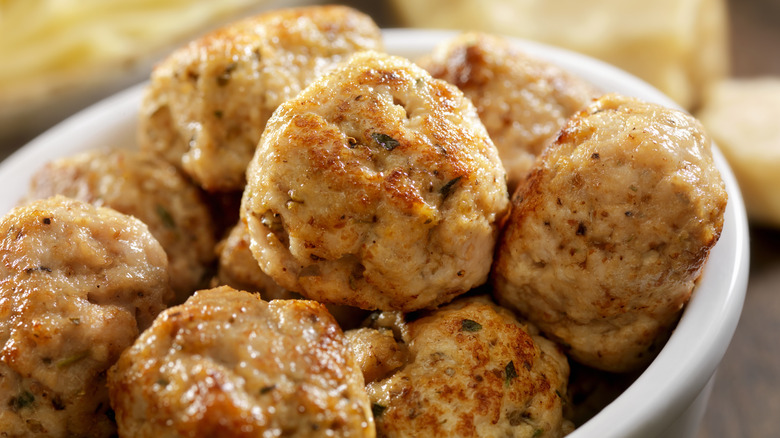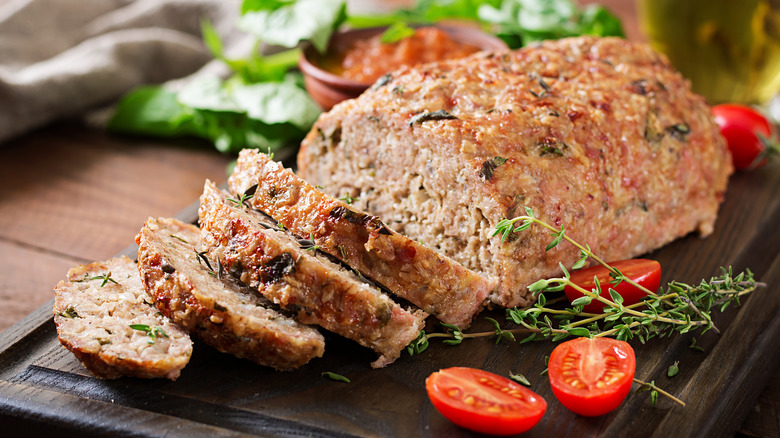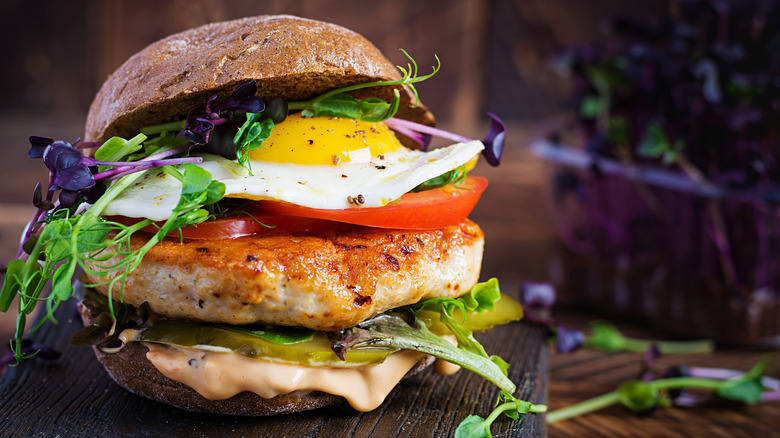How To Show Ground Turkey Meat Some Extra Love To Prevent It From Drying Out
If you've ever questioned why your nonna's classic Italian meatballs or your mom's meatloaf recipe calls for breadcrumbs and milk, it's to make a moist interior. Breadcrumbs or bread get soaked in a liquid, usually milk, before being mixed into the meat. This is called a panade, and the extra moisture from the milk mixing with the starchy breadcrumbs goes a long way to preventing the meat from drying out. When it comes to cooking with leaner ground turkey, which is notoriously difficult to keep tender, making a panade is a step you shouldn't skip.
Some cooks prefer a panade made of equal parts breadcrumbs (or torn bread) and milk, which are incorporated and left to sit together for at least 10 minutes to ensure the mixture is moistened before adding to the ground turkey. Others favor a denser paste, using a tablespoon of milk for every ¼ cup of crumbs. While panko is a possibility for panade, because it is larger than Italian-style breadcrumbs, it requires slightly more liquid (around two extra spoonfuls). In meatballs or meatloaf, aim to zuzh up each pound of ground turkey with about ½ cup of panade. Without fail, you'll find that this starchy concoction is the key to triumphant ground turkey dishes.
A panade works because of how starches react to heat
Think of the last time you made a burger. What looked like a nice sized patty shrunk so much during cooking it might have only filled half the bun. When exposed to heat, meat proteins shrink as moisture evaporates. A panade helps to counteract this by blocking the shrinkage due to gelatinization. As the carbohydrates in a slice of bread or ½ cup of breadcrumbs heat up in a liquid — be it milk, buttermilk, broth or stock, or water — they soak up the liquid and gelatinize; this keeps ground meat moist. It's not a foolproof solution, though; a panade won't rescue an overworked meatball, meatloaf, or burger from being dense and rubbery. Take care in how you handle the meat and don't squeeze or pack the meat too much.
You might not need a panade if you're grilling up turkey burgers that actually taste good because the cook time won't be long enough for the starch proteins in the breadcrumbs to gelatinize due to the grill's high heat. Instead of tender inside, the burger could be loose and squidgy from the extra liquid. If you do go the panade route with your classic (not dry) turkey burgers, try searing them in a hot cast iron pan first, then finishing them off in the oven. This will ensure that the starches have time to work their magic, leaving you with a juicy turkey burger.
If a panade isn't for you, there are different ways to ensure a moist turkey burger
Besides using a panade to prevent dry ground turkey, there are other ways to show some love to the lean meat. For starters, minced mushrooms or grated butter are a few of the ways to add moisture to ground turkey. Mushrooms are full of water — around 90% – and will keep the meat tender, while a tablespoon of unsalted butter contains about 12 grams of fat. Both options will add much-needed richness and texture to replace what gets cooked out, elevate the mouthfeel, and add plenty of extra flavor.
When it comes to cooking ground turkey, you should aim for temperature instead of time or color. The USDA advises that your dish should reach an internal temperature of 165 degrees Fahrenheit to prevent foodborne illnesses. If you have an instant-read probe thermometer, insert it horizontally into the middle of the meat from the side to get the most accurate reading. When your burger or meatloaf hits 165 degrees Fahrenheit, you'll want to make sure to pull it from the heat as quickly as possible to prevent overcooking and dry, crumbly turkey.


